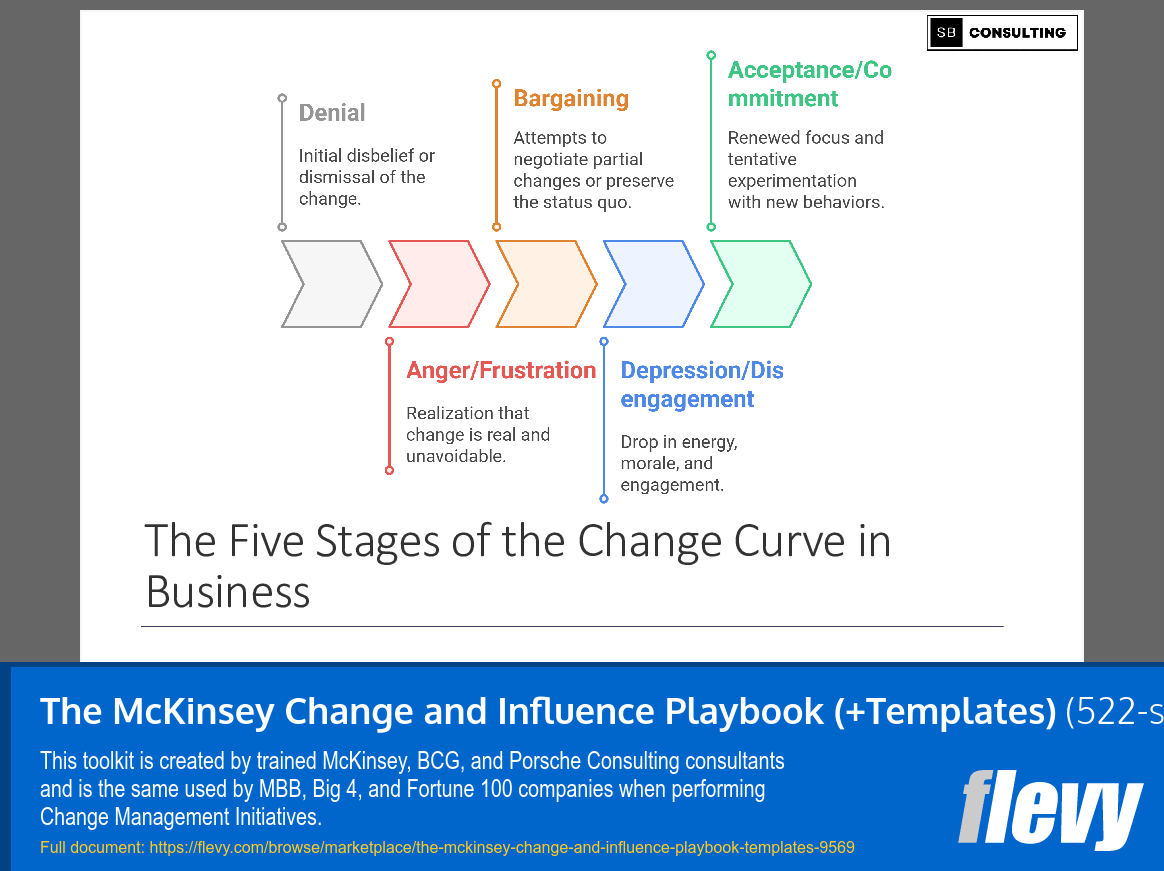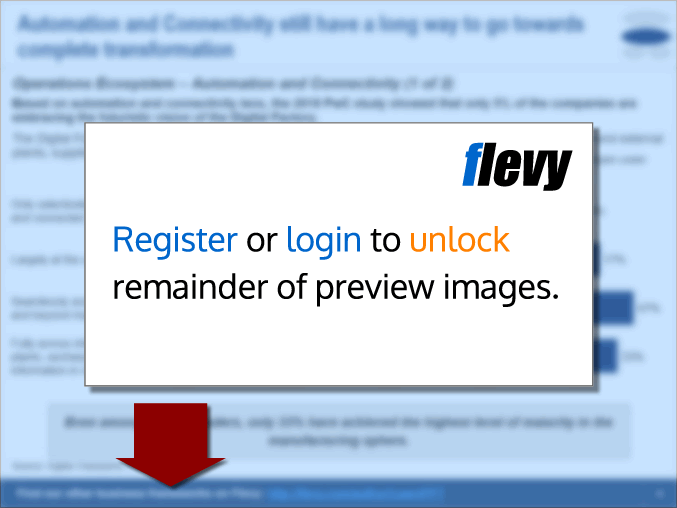McKinsey Change and Influence Playbook (+Templates) (PowerPoint PPTX Slide Deck)
PowerPoint (PPTX) + Excel (XLSX) 522 Slides
BENEFITS OF THIS POWERPOINT DOCUMENT
- Provides a step-by-step blueprint for leading successful organizational change in any industry.
- Offers practical tools and templates to drive behavioral change and measure impact effectively.
- Equips leaders with proven strategies to build a resilient culture and sustain transformation.
CHANGE MANAGEMENT PPT DESCRIPTION
Curated by McKinsey-trained Executives
Unlock Unstoppable Organizational Growth with the Complete McKinsey Change Playbook
In today's fast-paced, hyper-competitive business world, successful change management is no longer optional – it's critical for survival and growth. Yet, research shows nearly 70% of organizational change efforts fail, costing millions in lost productivity, stalled innovation, and plummeting morale.
Are you ready to break the cycle of change failure and lead transformative initiatives that stick?
Introducing the Complete McKinsey Change Playbook – a comprehensive, battle-tested, and expertly crafted guide that equips executives, change managers, HR leaders, and consultants with everything needed to drive breakthrough change and sustainable results.
Why the McKinsey Change Playbook is the #1 Tool for Change Success in 2025
This isn't just another theoretical manual. The McKinsey Change Playbook delivers a practical, step-by-step blueprint based on decades of proven research and McKinsey's signature Influence Model. You get:
• Over 500 meticulously designed PowerPoint slides that cover every facet of change management—from foundational theories to advanced influence tactics and leadership strategies.
• A full suite of easy-to-use Excel templates including stakeholder matrices, change readiness surveys, behavior assessment tools, and implementation scorecards – everything you need to plan, monitor, and scale your change program.
• Insights into cutting-edge behavioral science and neuroscience that explain why people resist change and how to win hearts and minds.
• Frameworks for building a culture of change agility that turns disruption into opportunity.
• A comprehensive guide on transformational leadership skills to inspire and empower teams through uncertainty.
• Strategies to embed change into organizational structures, processes, and technology for lasting impact.
• Expert tactics for communication, engagement, and managing resistance—all tailored to today's dynamic business environment.
CONTENT OVERVIEW
PART I: Foundations of Change Management
1. Introduction to Organizational Change
1.1 The Accelerating Pace of Change in the 21st Century
1.2 Strategic Drivers of Organizational Change (Technology, Competition, Regulation, Sustainability)
1.3 Dimensions of Change: People, Process, Structure, Strategy
1.4 Types of Change: Evolutionary, Revolutionary, Developmental, Transformational
1.5 The Cost of Change Failure: Organizational, Cultural, Financial
1.6 The Opportunity in Change: Growth, Innovation, Resilience
2. Change Management Theories
2.1 Early Behaviorist Models and Scientific Management
2.2 Lewin's Three-Stage Model and Its Enduring Legacy
2.3 Kotter's 8-Step Model: Creating Urgency to Anchoring Change
2.4 ADKAR: Individual Focus in Organizational Change
2.5 Bridges' Transition Model: The Psychological Journey
2.6 Comparison of Classical and Contemporary Models
2.7 Toward Influence-Based and Systems-Centric Approaches
3. Understanding the Human Side of Change
3.1 The Neuroscience of Change: Brain, Habit, Fear
3.2 Cognitive Biases and Behavioral Resistance
3.3 Psychological Safety and Trust in Change Adoption
3.4 Change Fatigue and Burnout: Symptoms and Solutions
3.5 The Change Curve (Kubler-Ross) in Organizational Context
3.6 Stakeholder Mapping and Influence Dynamics
3.7 Communication, Empathy, and Emotional Intelligence in Engagement
PART II: The McKinsey Influence Model – Four Building Blocks of Change
4. Overview of the McKinsey Influence Model
Overview of McKinsey
4.1 Origins of the McKinsey Model
4.2 Key Concepts in Behavioral Influence and Habit Formation
4.3 Overview of the Four Building Blocks
4.4 Why Influence Outperforms Command-and-Control Models
4.5 Behavioral Science Principles Behind Each Block
4.6 When and Where to Apply the Influence Model
Block 1: Fostering Understanding and Conviction
5. Creating a Compelling Change Narrative
5.1 The Role of Narrative in Shaping Organizational Identity
5.2 Crafting a Vision That Resonates with All Levels
5.3 The Power of Why: Anchoring Conviction in Purpose
5.4 Tailoring Messages to Different Audiences
5.5 Communicating in Crisis vs. Communicating for Growth
5.6 Tools for Storytelling and Emotional Engagement
6. Building Meaning and Belief Through Strategic Alignment
6.1 Aligning Change with Personal and Organizational Values
6.2 Connecting Strategy to Daily Work
6.3 Deconstructing Misaligned Mental Models
6.4 Using Internal Campaigns to Shift Beliefs
6.5 Social Proof and Collective Commitment
6.6 Reinforcing Belief Through Rituals, Language, and Symbols
Block 2: Reinforcing Change Through Formal Mechanisms
7. Aligning Structures, Policies, and Processes
7.1 Embedding Change into Governance and Operating Models
7.2 Process Redesign for Change Enablement
7.3 Changing Incentive Systems to Drive New Behaviors
7.4 Aligning Compliance, Risk, and Internal Controls
7.5 Role Clarity and Job Redesign
8. Systems and Technology as Change Enablers
8.1 Technology as a Catalyst and Barrier to Change
8.2 IT System Redesign for Behavioral Reinforcement
8.3 Integrating Change Tools into Daily Workflows
8.4 The Role of Analytics and Dashboards in Behavior Monitoring
8.5 Supporting Infrastructure: Digital Learning, Collaboration Platforms, Process Automation
9. Embedding Feedback and Accountability Mechanisms
9.1 KPIs and Metrics to Track Behavioral Shifts
9.2 Creating Cascading Scorecards and Accountability Chains
9.3 Using Recognition Systems to Reward Aligned Behavior
9.4 Auditing Change Outcomes: Internal and External Reviews
9.5 Using Pulse Surveys and Real-Time Feedback Tools
Block 3: Developing Talent and Skills
10. Diagnosing Skills and Capability Gaps
10.1 Change-Critical Competencies by Role and Level
10.2 Tools for Capability Gap Assessment
10.3 Balancing Technical and Behavioral Skills
11. Designing and Delivering Capability Development
11.1 Curriculum Development for Change Enablement
11.2 Personalized Learning Pathways and Learning Experience Platforms
11.3 Coaching and Mentorship to Reinforce Learning
11.4 Simulation, Role-Play, and On-the-Job Learning
12. Institutionalizing Learning and Knowledge Sharing
12.1 Knowledge Management Systems and Communities of Practice
12.2 Embedding Learning in Daily Routines
12.3 Leadership Development and Succession Planning
12.4 Culture of Experimentation and Iteration
Block 4: Role Modeling
13. Authentic Leadership in Times of Change
13.1 Role Modeling as the Most Powerful Form of Influence
13.2 Traits of Change-Effective Leaders
13.3 Closing the Say-Do Gap
13.4 Transparency, Courage, and Vulnerability in Action
14. Identifying and Empowering Informal Influencers
14.1 Finding Culture Carriers and Peer Leaders
14.2 Leveraging Network Mapping to Identify Influencers
14.3 Empowerment Frameworks for Distributed Leadership
14.4 Storytelling and Shadow of the Leader
15. Sustaining and Scaling Role Model Behavior
15.1 Behavior Tracking and Self-Awareness Tools
15.2 Rituals, Forums, and Leader Check-ins
15.3 Creating Peer Role Model Networks
15.4 Institutionalizing Leader Development Cycles
PART III: Enabling a Sustainable Culture of Change
16. Designing a Culture That Enables Change
16.1 Cultural Levers for Transformation
16.2 Diagnosing Current vs. Target Culture
16.3 Embedding Shared Purpose and Collective Identity
16.4 Aligning Rituals, Symbols, Language, and Space
17. Behavior Change at Scale
17.1 Using Behavioral Design and Nudge Theory
17.2 Habit Loops and Behavioral Reinforcement
17.3 Leveraging Defaults, Prompts, and Environmental Cues
17.4 Scaling Behavior Through Technology
18. Embedding Psychological Safety and Trust
18.1 Creating Safe Environments for Innovation
18.2 Inclusive Leadership and Diverse Thinking
18.3 Building Trust Across Functions and Levels
18.4 Addressing Fear and Vulnerability
PART IV: Becoming a Transformational Change Leader
19. Transformational Leadership in Change
19.1 Core Dimensions: Vision, Influence, Motivation, Challenge
19.2 Mindset Shifts: From Director to Enabler
19.3 Characteristics of Transformational Change Leaders
20. Building the Personal Toolkit for Change Leadership
20.1 Emotional Intelligence and Mindfulness
20.2 Self-Awareness and Adaptive Capacity
20.3 Leadership Communication in High-Stakes Change
20.4 The Art of Listening, Inquiry, and Feedback
21. Practicing Transformational Leadership in Real-World Contexts
21.1 Leading Through Ambiguity and Complexity
21.2 Empowering Teams in a Change Environment
21.3 Resilience and Energy Management for Leaders
21.4 Leadership Transitions During Organizational Shifts
21.5 Your Personal Development Roadmap
PART V: Implementation and Application
22. Designing and Executing a Change Program
22.1 Defining the Change Vision and Objectives
22.2 Change Governance Structures and Roles
22.3 Building the Change Roadmap and Milestones
22.4 Managing Dependencies and Resource Allocation
22.5 Continuous Improvement Cycles
23. Stakeholder and Communication Management
23.1 Comprehensive Stakeholder Analysis
23.2 Communication Strategy: Channels, Messages, Timelines
23.3 Engagement Through Co-Creation and Dialogue
23.4 Managing Political and Cultural Barriers
23.5 Crisis Communications During Change
24. Contextualizing Change Management
24.1 Change in Digital Transformation Programs
24.2 Post-Merger Integration and Cultural Assimilation
24.3 ESG and Purpose-Driven Transformation
24.4 Government and Nonprofit Change Models
24.5 Startups vs. Corporations: Change Capacity Differences
PART VI: Tools, Templates, and Resources
Practical Tools and Frameworks
Influence Model Diagnostic Tool (Excel)
Leadership Behavior Assessment
Strategic Change Canvas
Stakeholder Management Matrix
Change Readiness Survey
Post-Implementation Success Scorecard
McKinsey Influence Model Checklist
Change Leader Self-Assessment Form
Sample Change Communication Plan
Ready to Transform Your Organization's Future?
Whether you're a CEO, CHRO, change consultant, or project leader, the Complete McKinsey Change Playbook is your go-to resource for mastering change management in 2025 and beyond.
Don't risk another failed change initiative. Equip yourself with the world's most comprehensive and practical change leadership system.
👉 Get instant access now to the 500+ slide deck and Excel toolkit and start transforming your organization today.
Key Words:
Strategy & Transformation, Growth Strategy, Strategic Planning, Strategy Frameworks, Innovation Management, Pricing Strategy, Core Competencies, Strategy Development, Business Transformation, Marketing Plan Development, Product Strategy, Breakout Strategy, Competitive Advantage, Mission, Vision, Values, Strategy Deployment & Execution, Innovation, Vision Statement, Core Competencies Analysis, Corporate Strategy, Product Launch Strategy, BMI, Blue Ocean Strategy, Breakthrough Strategy, Business Model Innovation, Business Strategy Example, Corporate Transformation, Critical Success Factors, Customer Segmentation, Customer Value Proposition, Distinctive Capabilities, Enterprise Performance Management, KPI, Key Performance Indicators, Market Analysis, Market Entry Example, Market Entry Plan, Market Intelligence, Market Research, Market Segmentation, Market Sizing, Marketing, Michael Porter's Value Chain, Organizational Transformation, Performance Management, Performance Measurement, Platform Strategy, Product Go-to-Market Strategy, Reorganization, Restructuring, SWOT, SWOT Analysis, Service 4.0, Service Strategy, Service Transformation, Strategic Analysis, Strategic Plan Example, Strategy Deployment, Strategy Execution, Strategy Frameworks Compilation, Strategy Methodologies, Strategy Report Example, Value Chain, Value Chain Analysis, Value Innovation, Value Proposition, Vision Statement, Corporate Strategy, Business Development, Busienss plan pdf, business plan, PDF, Biusiness Plan DOC, Bisiness Plan Template, PPT, Market strategy playbook, strategic market planning, competitive analysis tools, market segmentation frameworks, growth strategy templates, product positioning strategy, market execution toolkit, strategic alignment playbook, KPI and OKR frameworks, business growth strategy guide, cross-functional strategy templates, market risk management, market strategy PowerPoint dec, guide, ebook, e-book ,McKinsey Change Playbook, Organizational change management toolkit, Change management frameworks 2025, Influence model for change, Change leadership strategies, Behavioral change in organizations, Change management PowerPoint templates, Transformational leadership in change
NOTE: Our digital products are sold on an "as is" basis, making returns and refunds unavailable post-download. Please preview and inquire before purchasing. Please contact us before purchasing if you have any questions! This policy aligns with the standard Flevy Terms of Usage.
Got a question about the product? Email us at support@flevy.com or ask the author directly by using the "Ask the Author a Question" form. If you cannot view the preview above this document description, go here to view the large preview instead.
Source: Best Practices in Change Management, Influence PowerPoint Slides: McKinsey Change and Influence Playbook (+Templates) PowerPoint (PPTX) Presentation Slide Deck, SB Consulting









